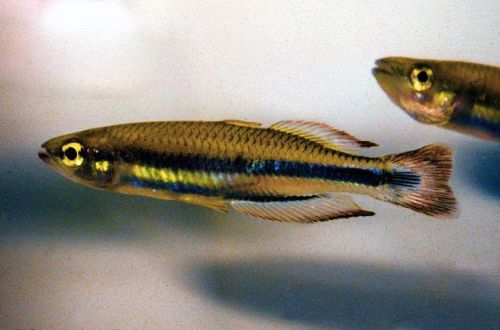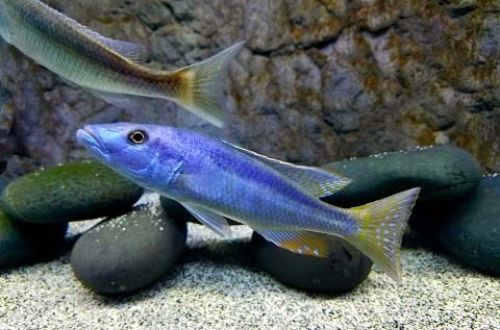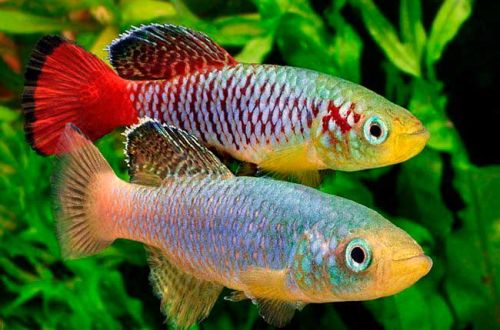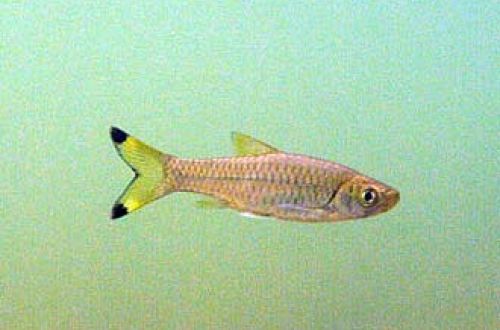
red-tailed bedocia
Red-tailed Bedotia, scientific name Bedotia geayi, belongs to the family Bedotiidae (Madagascar iris). A brightly active fish that is difficult to keep due to the need to maintain very high water quality.

Contents
Habitat
Endemic to the island of Madagascar. Inhabits the Mananjary River basin. It occurs in the upper and middle reaches in streams, rivers flowing among the tropical rainforest. Dense aquatic vegetation grows along the banks of the rivers, and the branches of trees tend to the surface. The substrates are rocky or sandy.
Brief information:
- The volume of the aquarium – from 200 liters.
- Temperature – 22-25°C
- Value pH — 6.5–8.5
- Water hardness – 10–25 dGH
- Substrate type – any dark
- Lighting – subdued
- Brackish water – no
- Water movement – moderate
- The size of the fish is about 9 cm.
- Food – any food
- Temperament – peaceful
- Content in a group of 8-10 individuals
Description
Adults reach a length of up to 9 cm. The fish has a yellowish body color with two distinct dark stripes. The first stretches from head to tail, echoing along the abdomen. Males are more brightly colored. During the breeding season, a red spot appears on their head. The dorsal and anal fins are pointed and have a black and yellow edging with additional red tints. In females, the dorsal and anal fins are rounded with a predominance of yellow.
Food
Omnivorous species, accepts most of the popular food in the aquarium trade in dry, frozen and live form. Protein-rich foods are a good choice.
Maintenance and care, arrangement of the aquarium
Red-tailed bedocia are very mobile, therefore they need a spacious aquarium, the optimal size of which for a group of 8-10 fish starts from 200 liters. The presence of a lid is desirable to prevent accidental jumping out. The design should include areas of open water for swimming and places for shelters in the form of thickets of plants. It is noted that the subdued level of lighting and dark soil, along with high-quality feed, helps to preserve the brightness of the color. On the contrary, an abundance of light and a variegated substrate make the fish faded.
Water quality is of key importance for long-term maintenance. Being a native of flowing water bodies, Bedocia are sensitive to the accumulation of organic waste. Regular cleaning of the aquarium, weekly replacement of part of the water (25-50% of the volume) with fresh water and the installation of a productive filtration system are mandatory.
Behavior and Compatibility
They prefer to be in a group of 6 individuals. Set up peacefully in relation to relatives and other fish. May be overly active for slow species.
Breeding / breeding
A species aquarium with water of medium hardness, a moderate current and the presence of thickets of plants, where spawning will take place, will become a favorable breeding environment. Fish lay eggs, attaching them to the surface of plants. The process can take several weeks. The incubation period lasts about 7-10 days. Parents are usually indifferent to their offspring, do not show concern, but do not try to eat it either. However, many breeders prefer to move the fry to a separate tank.
Fish diseases
In a favorable environment, cases of the disease are rare. When the first symptoms of the disease appear (lethargy, deformation of the body, the appearance of spots, etc.), it is first necessary to check the quality of the water. Probably, bringing all indicators of the habitat back to normal will allow the body of the fish to cope with the disease on its own. Otherwise, medical treatment will be required. Read more in the section “Diseases of aquarium fish”.





